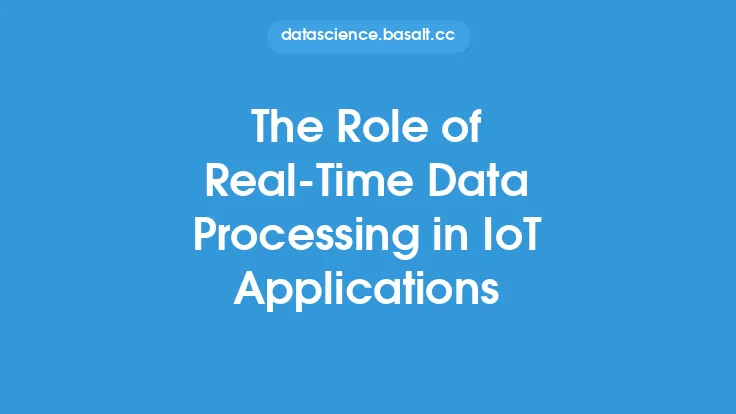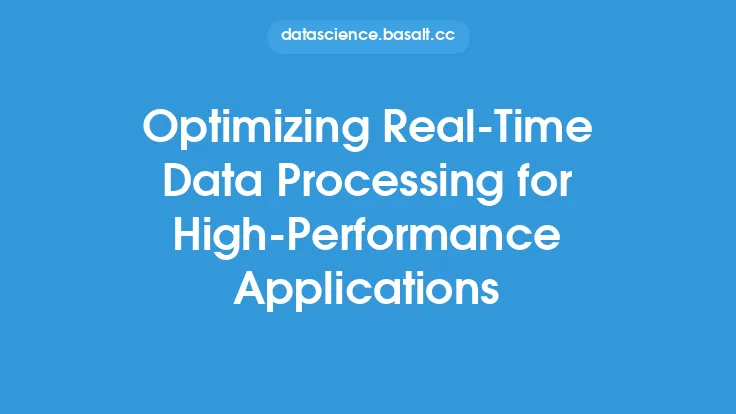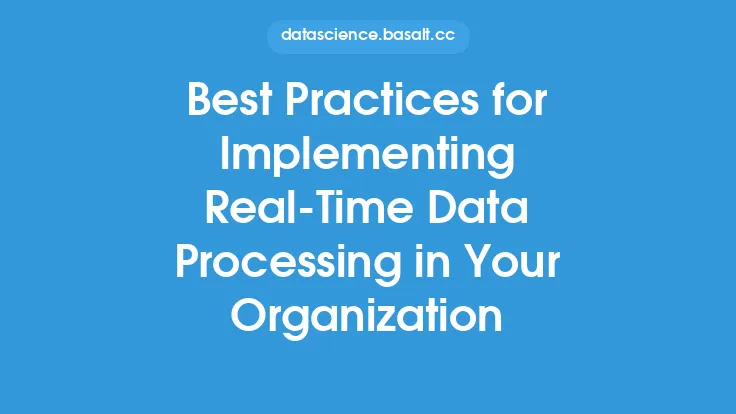Real-time data processing is a critical component of modern data engineering, enabling organizations to extract insights and value from their data as it is generated. This approach to data processing has become increasingly important in today's fast-paced, data-driven world, where the ability to respond quickly to changing circumstances can be a key differentiator. In this article, we will delve into the world of real-time data processing, exploring its fundamentals, benefits, and challenges, as well as the technologies and techniques used to support it.
Introduction to Real-Time Data Processing
Real-time data processing refers to the ability to process and analyze data as it is generated, in real-time. This approach to data processing is designed to support applications that require immediate insights and decision-making, such as financial trading, IoT sensor data processing, and social media analytics. Real-time data processing involves the use of specialized technologies and techniques that enable data to be processed and analyzed quickly, often in a matter of milliseconds. This allows organizations to respond rapidly to changing circumstances, making it an essential component of modern data engineering.
Benefits of Real-Time Data Processing
The benefits of real-time data processing are numerous and significant. Some of the most important advantages include:
- Improved decision-making: Real-time data processing enables organizations to make informed decisions quickly, based on the latest data and insights.
- Increased efficiency: By processing data in real-time, organizations can automate many tasks and processes, reducing the need for manual intervention and increasing overall efficiency.
- Enhanced customer experience: Real-time data processing can be used to support personalized customer experiences, such as recommendation engines and real-time marketing.
- Competitive advantage: Organizations that can process and analyze data in real-time can respond more quickly to changing circumstances, giving them a competitive advantage in the market.
Challenges of Real-Time Data Processing
While real-time data processing offers many benefits, it also presents several challenges. Some of the most significant challenges include:
- Scalability: Real-time data processing requires systems that can handle large volumes of data, often with low latency and high throughput.
- Data quality: Real-time data processing requires high-quality data, which can be a challenge in environments where data is generated quickly and in large volumes.
- Complexity: Real-time data processing often involves complex systems and architectures, which can be difficult to design, implement, and maintain.
- Cost: Real-time data processing can be expensive, particularly when it comes to the cost of hardware, software, and personnel.
Technologies Used in Real-Time Data Processing
Several technologies are used to support real-time data processing, including:
- Streaming data platforms: Platforms such as Apache Kafka, Apache Storm, and Apache Flink are designed to handle high-volume, high-velocity data streams.
- In-memory data grids: Technologies such as Apache Ignite and Hazelcast provide in-memory data storage and processing, enabling fast data access and processing.
- NoSQL databases: Databases such as Apache Cassandra and MongoDB are designed to handle large volumes of unstructured or semi-structured data, often with low latency and high throughput.
- Cloud-based services: Cloud-based services such as Amazon Kinesis and Google Cloud Pub/Sub provide scalable, on-demand infrastructure for real-time data processing.
Techniques Used in Real-Time Data Processing
Several techniques are used to support real-time data processing, including:
- Event-driven architecture: This approach to software design involves building systems that respond to events, such as changes in data or user interactions.
- Stream processing: This technique involves processing data in real-time, as it is generated, often using streaming data platforms.
- Microservices architecture: This approach to software design involves building systems as a collection of small, independent services, each of which can be developed, deployed, and scaled independently.
- Machine learning: Machine learning algorithms can be used to analyze data in real-time, enabling predictive analytics and automated decision-making.
Best Practices for Real-Time Data Processing
To get the most out of real-time data processing, organizations should follow several best practices, including:
- Define clear goals and objectives: Real-time data processing should be aligned with clear business goals and objectives, such as improving customer experience or increasing efficiency.
- Choose the right technologies: The choice of technology will depend on the specific use case and requirements, such as scalability, data quality, and latency.
- Design for scalability: Real-time data processing systems should be designed to scale, both in terms of data volume and processing capacity.
- Monitor and optimize performance: Real-time data processing systems should be monitored and optimized regularly, to ensure that they are performing at optimal levels.
Conclusion
Real-time data processing is a critical component of modern data engineering, enabling organizations to extract insights and value from their data as it is generated. While it presents several challenges, the benefits of real-time data processing are significant, including improved decision-making, increased efficiency, and enhanced customer experience. By understanding the fundamentals, benefits, and challenges of real-time data processing, and by following best practices and using the right technologies and techniques, organizations can unlock the full potential of their data and gain a competitive advantage in the market.





